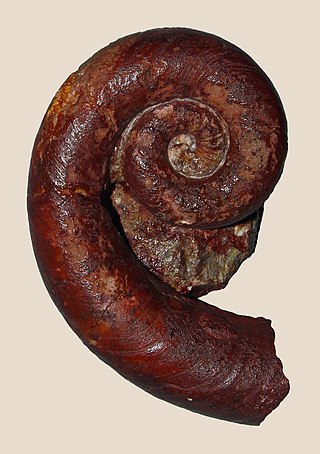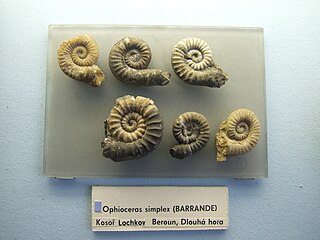
Lituites is an extinct nautiloid genus from the Middle Ordovician and type for the Lituitidae that in some more recent taxonomies has been classified with the orthocerids and listed under the order Lituitida. Fossils have been found in New York, Argentina, Norway, Sweden, Estonia, and China.
The Ellesmerocerida is an order of primitive cephalopods belonging to the subclass Nautiloidea with a widespread distribution that lived during the Late Cambrian and Ordovician.

Aphetoceras is a genus of tarphycerid cephalopod within the Estonioceratidae; loosely coiled without an impression along the dorsal margin; early whorls barely reaching, separating then diverging in the final mature whorl; weakly ribbed in some. The cross section of Aphetoceras is higher than wide, making it compressed in form. The dorsum, along the inner curve, is more broadly rounded than the venter which lies along the outer curve. The siphuncle is relatively large, located near but not at the ventral margin; lined with secondary deposits. Chambers are empty.
Clarkoceras is a genus of breviconic ellesmerocerid cephalopods, one of only two genera known to have crossed from the Late Cambrian, Trempealeauan, into the Early Ordovician, Gasconadian. ; the other being Ectenolites.

The Tarphycerida were the first of the coiled cephalopods, found in marine sediments from the Lower Ordovician to the Middle Devonian. Some, such as Aphetoceras and Estonioceras, are loosely coiled and gyroconic; others, such as Campbelloceras, Tarphyceras, and Trocholites, are tightly coiled, but evolute with all whorls showing. The body chamber of tarphycerids is typically long and tubular, as much as half the length of the containing whorl in most, greater than in the Silurian Ophidioceratidae. The Tarphycerida evolved from the elongated, compressed, exogastric Bassleroceratidae, probably Bassleroceras, around the end of the Gasconadian through forms like Aphetoceras. Close coiling developed rather quickly, and both gyroconic and evolute forms are found in the early middle Canadian.

Lituitida is an order of orthoceratoid cephalopods. They correspond to the family Lituitidae of the Treatise, reranked as an order and combined with other orthoceratoids. They are considered to be more closely related to the Orthocerida than to the Ascocerida or Pseudorthocerida which are also included.
Anthoceras is a genus of straight, annulated, proterocamerioceratids from the Lower Ordovician, found in North America, NW Australia, and Siberia. The cross section is circular, the siphuncle moderately large, and marginal. Segments are constricted ; septal necks hemichoantici to subholochoantic ; connecting rings thick. Endocones are long and slightly asymmetric.

The Ellesmeroceratidae constitute a family within the cephalopod order Ellesmerocerida. They lived from the Upper Cambrian to the Lower Ordovician. They are characterized by straight and endogastric shells, often laterally compressed, so the dorso-ventral dimension is slightly greater than the lateral, with close spaced sutures having shallow lateral lobes and a generally large tubular ventro-marginal siphuncle with concave segments and irregularly spaced diaphragms. Connecting rings are thick and layered, externally straight but thickening inwardly with the maximum near the middle of the segment so as to leave concave depressions on internal siphuncle molds. Septal necks are typically orthochoanitic but vary in length from almost absent (achoanitic) to reaching halfway to the previous septum (hemichoanitic) and may even slope inwardly (loxochoanitic).
The Reudemannoceratidae are the ancestral and most primitive of the Discosorida, an order of cephalopods from the early Paleozoic. The Reudemannoceratidae produced generally medium-sized endogastric and almost straight shells with the siphuncle slightly ventral from the center.

The Trocholitidae are Tarphycerida with whorls in close contact as with the Tarphyceratidae, but in which the siphuncle, similar in structure, becomes dorsal. The Trocholitidae are derived from the Tarphyceratidae, perhaps from different tarphyceratids.
The Genus Hemichoanella is a small, extinct, orthoconic nautiloid cephalopod from the Lower Ordovician of Western Australia assigned to the orthoceratoid family, Baltoceratidae. Hemichoanella and the Baltoceratidae are part of the subclass of once diverse and numerous shelled cephalopods known as the Nautiloidea.
Baltoceratidae is an extinct family of orthoconic cephalopods belonging to the subclass Nautiloidea endemic to what would be Asia, Australia, Europe, North America, and South America during the Ordovician living from about 480–460 mya, existing for approximately 20 million years.

Proteoceratidae is an extinct family of actively mobile aquatic carnivorous cephalopods belonging to the subclass Orthoceratoidea endemic to what would be Asia, Australia, Europe, South America and North America during the Ordovician living from 490—445.6 Ma, existing for approximately 44.4 million years.
Cochlioceras is an extinct baltoceratid genus from the lower and middle Ordovician of what are now Europe, the U.S. (Vermont), and China, having existed for approximately 14 million years, from about 478 to 464 mya.

Narthecoceratidae is an extinct family of orthocone cephalopods who lived in marine environments in what is now North America during the Ordovician from 460.5—449 mya, existing for approximately 11.5 million years.

The Lituitidae are a family of evolved tarphycerids characterized by a long orthoconic section that follows a coiled juvenile portion at the apex, along with a generally tubular siphuncle, which like that of the barrandeocerids is composed of thin connecting rings.
Lobendoceras is a proterocameraceratid with a rather large, moderately expanded, straight shell with a large marginal siphuncle in which sutures have a broad, deep, ventral lobe and septal necks are subholochoanitic to holochoanitic.
Bassleroceras is an elongate upwardly curved, exogastric, genus with the venter on the under side more sharply rounded than the dorsum on the upper. The siphuncle is ventral, composed of thick-walled tubular segments in which connection rings thicken in towardly as in both the Ellesmerocerida and primitive Tarphycerida.

The Estonioceratidae are a family of loosely coiled tarphycerids in which the inner side of the whorls, which forms the dorsum, is rounded or flat with no impression, and in which the siphuncle, composed of thick tubular segments, is located ventrally. The Estonioceratidae seem to form a link between the ancestral Bassleroceratidae and the more tightly coiled Tarphyceratidae.

Ophioceras is a genus of closely coiled tarphycerid nautiloid cephalopods, the sole representatives of the family Ophidioceratidae, characterized by an evolute shell with narrow, subrounded, annulated whorls and a subcentral siphuncle composed of thin connecting rings that show no evidence of layering. The mature body chamber is strongly divergent and is the longest proportionally of any tarphycerid. The aperture has a deep hyponomic sinus and ocular sinuses, and so resembles some lituitids.










